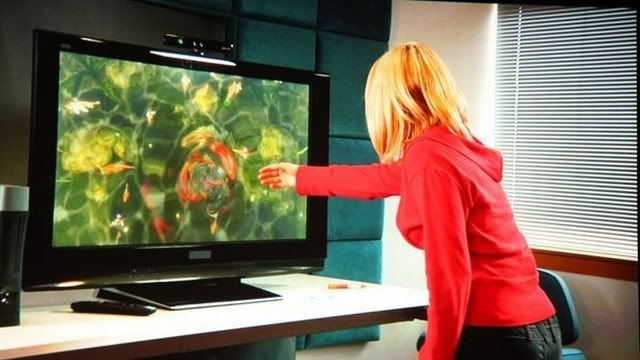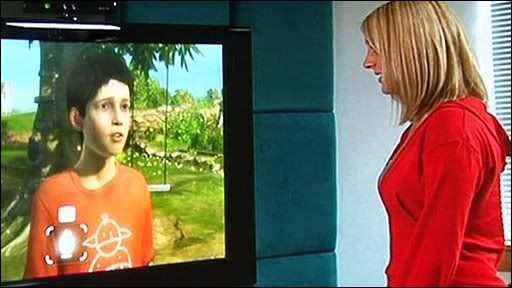
Virtual reality – or at least fun, affordable, complex virtual reality – is still a long way away. In fact, it is our valuable opinion that – dare we say it – virtual reality will never be casual entertainment for the masses. How very dare we! But what’s the next best thing? Project Natal. No, let us rephrase that: the next best thing is what Project Natal promises it will be.
Imagine playing games and using programs on your TV where the only controller you need is your body. Playing air guitar and pretending you’re fighting a lightsaber duel when nobody’s looking (er, that’s normal, right?) could be your new way of playing the latest games. Every little movement of your body translated into action by your on screen avatar. Not only that, but the game will recognise your face, body and voice. No friends? Make some!! All sounds awesome, doesn’t it? And this last idea of holding a conversation with a virtual person is explored in the ‘Milo’ video above (which, yes, you’ve probably already seen). We…we don’t believe it! Could it be true? Has the revolution finally come? Hang on a minute. Who’s the Microsoft monkey talking about Natal between clips of the demonstration?
Damn. It’s Peter Molyneaux.
Molyneaux and his teams at first Bullfrog and now Lionhead, have given us some fantastic games. Nonetheless, he seems to have a taste for pies – of the porky variety. More than once he’s promised much more than he’s been able to deliver. We’re casting a Critical Eye over Project Natal here, not Peter Molyneaux; but if you need evidence of his tendency to exaggerate, use Google to investigate what he promised Fable would provide, and what the finished product actually delivered.
Milo is the name of the young boy in the Natal tech demo software. The name of the woman using Natal (presumably they couldn’t find a man willing to play something without anything to kill or copulate with) is Clare, or possibly Claire, or maybe Clayerrrr. They call each other by name, in an attempt to emphasise the feeling of a natural conversation. This only emphasises the feeling of a business presentation.

NOOO!!! Haven't you played Persona 4?!!?
Very early in the demo, ‘Milo’ asks Clare what’s wrong, as he thinks she seems nervous. Molyneaux leaps on this, gushing about how Natal recognises emotions. What he doesn’t mention is that Clare actually said she was feeling nervous moments before. Still, it’s a nice piece of voice recognition. Even if Nintendo got there first with the DS.
The idea of emotions being recognised both ways is also promised, when Molyneaux gets overexcited about Clare knowing something’s up with Milo. He talks about how Milo doesn’t meet Clare’s eyes, and how he keeps his head down. What he certainly doesn’t talk about, is how all but the most gullible observers will know that the whole demonstration was carefully scripted from start to finish. There would have been no surprises for Clare, and this was clear from the ease she slipped from one required action to the next, and how she just happened to have a pen and paper immediately available when required. For all we know she was playing along, after hours of careful rehearsal, with a non- interactive piece of recorded footage. We’re not saying that’s what we think happened – but how would you know?
One Molyneaux claim we think twice about dismissing, is the one about the goggles. He claims that every time Milo throws the pretend goggles to whoever is using Natal, that person reaches down to catch the non existent object before the necessary act of pretending to put them on. It’s possible; and if true, shows that even at this early stage, Natal encourages the player to immerse themselves in what they’re doing in a way most developers can only dream of.

We're undecided which is the most annoying.
The water ripple effects are very nice by the way, and seeing the player’s reflection in the disturbed water is jolly nice too.
The sequence where Clare helps Milo with his ‘school project(?)’ threatens to undermine completely the video’s supposed status as a practical demonstration of Natal. Milo says he’s having trouble drawing fish. Clare, with no prompting from Milo whatsoever, draws fish for him on a piece of paper. She then holds the paper up to Natal, which supposedly scans it into Milo’s world instantaneously.
Hmm.
Only somebody completely confident of what the hardware and software was capable of, and what it was expecting, would immediately try something like that without any kind of hint. If one of us tried something similar but it didn’t work, would we be left for the best part of an hour scratching our heads trying to work out what Milo was expecting us to do? At the end of the piece, Molyneaux declares that Natal is technology “science fiction has not even written about”. What we’re worried about at the moment, is that it’s more fiction than science.
Microsoft is well aware that what most Xbox 360 owners will want to know about Natal, is how it will be put to use for more traditional games. With this in mind, they released the following E3 announcement trailer with a bunch of examples. Our enthusiasm was dampened as soon as the trailer started, with the immediate disclaimer ‘Product vision: actual features and functionality may vary’. Translated into English, this comes out as ‘No working demos are used here. Everything you’re about to see is bull****’.
Do keep an eye out for the guy who leaps up from the sofa to change the wheel on an F1 car. He seems to take an almost orgasmic pleasure in doing so.
Oh, one more thing; every now and again, pause the video, and ask yourself: ‘How much of a prat would I feel doing that?’.
But we want to know! How many push ups can Chuck Norris do?
This ‘product vision’ is very, very similar to your average Wii ad. Frighteningly clean living room with plenty of space, nuclear family, happy bouncy music, so much smiling that you’re certain some kind of abuse is being masked; that kind of thing. Gamers who take pleasure in calling themselves ‘hardcore’ had better hope this isn’t an indication of Natal’s primary audience.
If Natal exploits even half of its full potential, we will embrace the device with open arms, and even finally forgive and forget the 360’s hideous failure rate. It would be the most successful and important invention in the world of video games since the Wii. If it turns out to be a big fat disappointment…well, don’t say we didn’t warn you about Molyneaux.







The thing that confuses me about this (well, a part of the video) is the boy with the skate board, scan your board into the computer, very cool, then chuck it behind your sofa and PRETEND to go out and play!!!
Erm, am I missing something here? He has the skate board, it’s a nice day outside, why is he pretending? Does he have a fear of the out-doors? Or the local bully’s hiding in his bushes? Maybe he’s grounded then?
Somebody TELL ME!!!
my guess is he’s loaded and not too smart. he obviously has the cash to buy the natal system, so why not have the money (or more likely willing parental cashflow) to buy him a skate board that he doesn’t know how to use, or perhaps his parents bought it in an attempt to distract him from the games. now he finally has a use for that blasted thing.
mostly conjecture taken from experience, parents bought me a skateboard one year and it turns out that hand eye coordination doesn’t mean jack when faced with balancing a moving , self propelled platform of death. it got relegated to holding up my tv over my playstation.
Sounds like a good use of a skateboard, well done! The skateboard I had as a kid had it’s wheels ripped off and was placed upon bricks in an attempt to get myself a ‘hoverboard’ from Back to the Future part 2!!!
LOL brilliant did the hoverboard work out
No, I kept falling off!!!